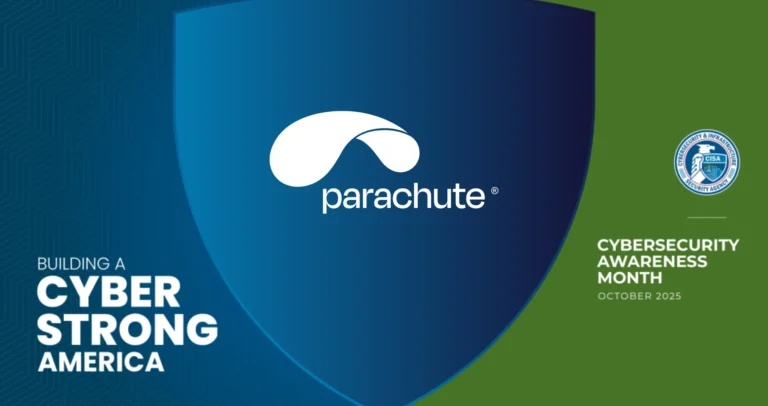Patrick Sullivan

Cybersecurity Awareness Month 2025 begins this October, led by the Cybersecurity and Infrastructure Security Agency (CISA) and the National Cybersecurity Alliance. Its mission is to help businesses, schools, and public agencies take practical steps to stay safe online.
A single phishing email or unpatched server can shut down operations, disrupt services, and destroy customer trust.
As a California-based Managed IT Services provider with more than 15 years of experience, Parachute has helped hundreds of SMBs and public agencies stop ransomware outbreaks, strengthen cyber hygiene, and protect critical infrastructure.
The 2025 theme, ‘Building a Cyber Strong America,’ calls on every organization to act now. With this guide, you’ll learn different steps you can take now to protect your business and team.
Key takeaways
- Join the 2025 theme, “Building a Cyber Strong America,” and strengthen national resilience.
- Secure your business, school, or agency against cyber threats targeting critical infrastructure.
- Practice the four essentials: spot phishing, use strong passwords, enable MFA, and update software promptly.
- Build resilience with continuous monitoring, encrypted backups, and strong incident response planning.
- Partner with Parachute to enhance supply chain security and create a lasting culture of cybersecurity.
What is Cybersecurity Awareness Month?
National Cybersecurity Awareness Month began in 2004 as a joint initiative of the Cybersecurity and Infrastructure Security Agency (CISA) and the National Cybersecurity Alliance. Its purpose is to give you and your organization practical tools to reduce risk and stay secure online.
Today, nearly every business, school, utility, and government agency is connected to critical infrastructure, which means a single weak link can have a ripple effect across an entire community. In 2024, U.S. organizations reported $16.6 billion in cybercrime losses from over 850,000 complaints. That’s a 33% jump from 2023.
That surge illustrates why this effort is essential. The 2025 theme, “Building a Cyber Strong America,” calls on small and midsized businesses (SMBs), vendors, and government partners to work together to combat cyber threats and maintain essential services.
Make cybersecurity a culture, not a checklist
Cybersecurity is more than software; it’s people, processes, and technology working together daily. A security-aware culture keeps teams alert and systems protected.
60% of breaches involve the human element, including social engineering, human error, and misuse. That means leadership needs to set the tone.
Run training sessions, use phishing simulations, and reward employees who report threats. Establish clear security standards for vendors and partners, and promote secure habits such as using password managers, locking screens, and treating security as a shared responsibility among all parties.
Four cybersecurity essentials everyone should practice
These steps form the foundation of security awareness and give you the highest return on effort.
Spot and avoid phishing attacks
- Train staff to recognize urgent requests, fake login pages, and AI-polished grammar.
- Warn staff about QR code risks and social media phishing scams.
- Give staff clear reporting steps for suspicious emails.
In 2024, Business Email Compromise accounted for 21,442 complaints and nearly $2.8 billion in reported losses. This demonstrates that phishing remains one of the most expensive and disruptive attacks you must defend against.
Use strong passwords
- Create passphrases at least 16 characters long.
- Require unique logins for every account.
- Adopt password managers for convenience and safety.
The National Institute of Standards and Technology NIST SP 800-63B-4 requires that user-chosen memorized passwords be at least 8 characters in length, recommends allowing up to 64 characters, and mandates checking new passwords against lists of commonly used or compromised passwords.
Turn on multi-factor authentication (MFA)
- Require MFA on accounts tied to finances, health, and work systems.
- Favor authenticator apps or security keys over weaker SMS codes.
- Choose phishing-resistant methods, as recommended by NIST Authenticator Assurance Level AAL2 and AAL3.
NIST AAL2 and AAL3 guidelines recommend phishing-resistant methods over text messages.
Update software regularly
- Enable automatic updates for operating systems, applications, and devices.
- Treat every update as a critical security fix.
- Prioritize patches for flaws on CISA’s Known Exploited Vulnerabilities (KEV) list.
Criminals actively exploit the flaws listed in CISA’s Known Exploited Vulnerabilities catalog.

Level up with advanced cybersecurity practices
Once you have the basics in place, you should raise the bar. Attackers count on missed updates and slow responses, but you can stop them by taking these steps:
- Log and monitor activity across your systems so you can spot suspicious behavior before it becomes a complete breach. The U.S. average cost of a data breach was approximately $4.4 million in 2025, a 9% drop that shows how much you can save by detecting and containing attacks quickly.
- Back up your data using the 3-2-1 rule: keep three copies, store them on two types of media, and keep one copy offsite. When you follow this approach, you reduce downtime and make ransomware recovery possible.
- Encrypt data so that even if attackers get in, they cannot read or use sensitive information. This step helps you protect data privacy and meet compliance requirements.
Taking these measures gives you a stronger foundation for incident response and builds confidence that you can recover quickly when something goes wrong.
Collaborate and share responsibility
Cybersecurity is a shared mission. You improve resilience across your community when you work with others:
- Report incidents quickly through CISA’s reporting portal so federal responders can help and alert others to emerging online threats.
- Share best practices with vendors, customers, and stakeholders to ensure consistent security across your supply chain.
- Host a webinar or in-person session with CISA toolkit materials to teach employees and neighbors about phishing, MFA, and software updates.
Ransomware complaints tied to U.S. infrastructure rose about 9 percent year over year, with nearly half targeting critical sectors such as manufacturing, healthcare, and government services. Working together strengthens national cyber defense and prepares everyone for the threats ahead.
Next, you will see why protecting critical infrastructure is one of the most important priorities for 2025.
Protect critical infrastructure
Small and midsized businesses and local governments are top targets because cybercriminals know they often have limited budgets and smaller security teams. These attacks create ripple effects that go far beyond your organization. One ransomware incident can shut down schools, delay healthcare appointments, or disrupt utilities for entire neighborhoods.
Small, consistent steps make a significant impact. When you strengthen your security controls, you protect not just your own operations but also the people and communities who depend on you.
Work with Parachute to strengthen defenses, stop cyberattacks, and recover fast while keeping your critical infrastructure secure.
Build a year-round cybersecurity program
Cybersecurity Awareness Month is just the starting point. You build lasting protection by turning security into an ongoing practice:
- Run quarterly phishing simulations to keep employees alert and reinforce security awareness training.
- Conduct annual IT risk assessments and vendor security reviews so you can close gaps before attackers find them.
- Partner with a Managed IT Services provider like Parachute for continuous monitoring, incident response readiness, and expert guidance.
According to NIST SP 800-66r2, consistent risk analysis, training, and planning help organizations maintain a strong security posture over time. Even incremental improvements, applied consistently, make your business much more difficult to breach.
Parachute can help you put these steps into action and turn cybersecurity from a one-time checklist into a year-round strategy.
Cyber threats never pause, and neither should your defenses
When you practice cybersecurity best practices by spotting phishing, using strong passwords, enabling MFA, and keeping systems updated, you make your business much more difficult to attack. Even small actions taken consistently create a significant impact and help you stay safe online.
Don’t wait until after an attack. Now is the perfect time to take the next step toward a stronger security posture.
Contact Parachute today for expert incident response, resilience planning, and risk management to secure your business.
FAQs
What are the most critical cybersecurity best practices for small businesses?
Start with phishing awareness, strong passwords, multi-factor authentication (MFA), and consistent patch management. Layer on endpoint detection and response (EDR), zero-trust network policies, and encrypted backups for enhanced protection. CISA recommends combining these steps to reduce ransomware, malware, and insider threats.
How can my team stay safe online and avoid malware infections?
Deploy EDR or advanced antivirus on every device and keep it updated through automated patch management. Train employees to spot phishing links and malicious downloads, then provide them with a transparent reporting process.
Why is security awareness training important for preventing cyberattacks?
Security awareness training helps employees recognize phishing, social engineering, and supply chain attacks, enabling them to protect themselves and their organizations better. It supports a least privilege model by making users aware of the risks associated with data handling. NIST recommends pairing training with incident response planning to shorten detection and recovery times.


